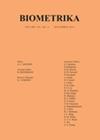双鲁棒函数的选择性机器学习
IF 2.8
2区 数学
Q2 BIOLOGY
引用次数: 0
摘要
虽然模型选择是参数和非参数回归或密度估计中一个研究得很好的主题,但半参数问题中可能高维干扰参数的选择却远远不够发达。在本文中,我们提出了一种选择性机器学习框架,用于对半参数模型上定义的有限维泛函进行推断,当后者允许双鲁棒估计函数和几种候选机器学习算法可用于估计干扰参数。基于双重鲁棒性所启发的伪风险的新定义,我们引入了一种新的选择准则,目的是在估计利息泛函时减少偏差。直观地,该准则选择了一对伪风险最小的学习器,使得估计函数对干扰参数的扰动最不敏感。我们为新选择标准的多重交叉验证版本建立了一个oracle属性,该属性表明我们的经验标准几乎与每对候选学习者的伪风险先验知识的oracle一样好。最后,我们将该方法应用于给定候选机器学习者集合的平均治疗效果的半参数估计量的模型选择,以解释我们在模拟和数据应用中说明的观察性研究中的混淆。本文章由计算机程序翻译,如有差异,请以英文原文为准。
Selective machine learning of doubly robust functionals
Abstract While model selection is a well-studied topic in parametric and nonparametric regression or density estimation, selection of possibly high-dimensional nuisance parameters in semiparametric problems is far less developed. In this paper, we propose a selective machine learning framework for making inferences about a finite-dimensional functional defined on a semiparametric model, when the latter admits a doubly robust estimating function and several candidate machine learning algorithms are available for estimating the nuisance parameters. We introduce a new selection criterion aimed at bias reduction in estimating the functional of interest based on a novel definition of pseudo-risk inspired by the double robustness property. Intuitively, the proposed criterion selects a pair of learners with the smallest pseudo-risk, so that the estimated functional is least sensitive to perturbations of a nuisance parameter. We establish an oracle property for a multi-fold cross-validation version of the new selection criterion which states that our empirical criterion performs nearly as well as an oracle with a priori knowledge of the pseudo-risk for each pair of candidate learners. Finally, we apply the approach to model selection of a semiparametric estimator of average treatment effect given an ensemble of candidate machine learners to account for confounding in an observational study which we illustrate in simulations and a data application.
求助全文
通过发布文献求助,成功后即可免费获取论文全文。
去求助
来源期刊

Biometrika
生物-生物学
CiteScore
5.50
自引率
3.70%
发文量
56
审稿时长
6-12 weeks
期刊介绍:
Biometrika is primarily a journal of statistics in which emphasis is placed on papers containing original theoretical contributions of direct or potential value in applications. From time to time, papers in bordering fields are also published.
 求助内容:
求助内容: 应助结果提醒方式:
应助结果提醒方式:


